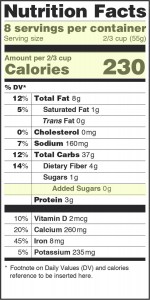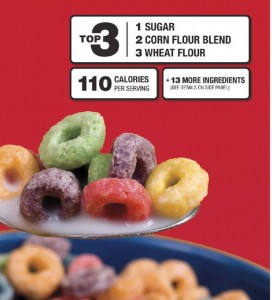The way that Kristina Carrillo-Bucaram transformed her life and her health is truly inspiring. At sixteen she was pre-diabetic with hyperglycemia. By eighteen, she suffered awful migraines, insomnia, depression, nausea, constipation, hair loss, skin problems, lack of confidence and her blood sugar issues remained. Continue reading “Raw vegan food can eliminate migraines and transform your health completely”
Sucres ajoutés seront cotées séparément des sucres totaux
FDA propose de nouvelles exigences en matière d’étiquetage pour le sucre et les édulcorants
Deux articles ont été publiés aujourd’hui dans le prestigieux New England Journal of Medicine sur la proposition de la FDA pour de nouvelles directrices sur l’étiquetage des aliments . La FDA est un organisme qui est fréquemment critiqué et rarement applaudi pour son progrès lents mais constant dans la protection des consommateurs.
David Kessler, l’ancien commissaire de la FDA qui a contribué à créer l’étiquette courant des valeurs nutritives, a déclaré que «réduire l’incidence des maladies liées à l’alimentation et la mortalité associée a été l’une des contributions les plus importantes que nous pourrions faire pour la santé publique. Notre objectif était de donner aux gens … des informations précises et faciles à lire qui les a encouragés à faire des choix alimentaires plus sains.”
L’étiquette originale en deçà de cet objectif, mais c’était un point de départ. Idéalement, la FDA aurait dû continuer à améliorer ses exigences en matière d’étiquetage afin de protéger les consommateurs contre les tactiques malhonnêtes de fabricants de produits alimentaires.
Vingt-cinq ans ont passé, et la FDA est enfin prêt à prendre son prochain «petit pas», la première révision de l’étiquette des aliments depuis sa création. Mais la mise à jour est loin d’être dramatique, et les changements peuvent même être difficiles à détecter (et j’ai donc pris la liberté de les mettre en évidence en jaune sur la photo, même si les étiquettes réels seront plaine noir et blanc). Une ligne sera ajoutée montrant les sucres ajoutés séparément des sucres totaux. Et les portions seront révisées afin de mieux refléter ce que les gens mangent réellement.
Ces petits changements visent spécifiquement à l’épidémie d’obésité. Kessler affirme que «durant la dernière décennie, nous avons appris beaucoup de choses sur les propriétés de renforcement de sucre et comment ils favorisent la suralimentation, et nous savons que les gens ont tendance à consommer les produits sucrés riches en calories au détriment des aliments riches en nutriments.”
En effet, 25 années nous ont appris plus que simplement «les sucres ajoutés conduisent à l’obésité”. Dans ce jeu proverbiale du chat et de la souris, les fabricants sont devenus gros ratons sous le nez d’un chat endormi.
Les fabricants utilisent encore les astuces suivantes pour éviter de dire aux consommateurs la vérité sur ses produits «alimentaires» qui contiennent rarement plus que des substances nutritionnellement vides de bas coût, et des additifs toxiques:
Au lieu de vrais ingrédients comme les fruits et légumes, qui sont plus coûteux et plus «problématique» en raison du fait que la vraie nourriture ne peut être tenu dans un entrepôt pendant des années, les fabricants utilisent des graines d’herbe asséchés et pulvérisés, (les grains) puis fortifier avec les vitamines synthétiques, en créant l’illusion d’un produit nutritif pour une fraction du coût. Magnifique!
Les fabricants remplissent leurs produits avec le sucre et les édulcorants artificiels addictifs, et les étiquent comme «faible en gras».
Les fabricants utilisent le type microscopique et de noms complexes pour induire le consommateur. La FDA exige actuellement que les ingrédients soit énumérés dans l’ordre décroissant en poids. Mais plutôt que d’énumérer “sucre” comme l’ingrédient n° 1, les fabricants ajoutent plusieurs édulcorants différents comme le fructose, le sirop de maïs, l’aspartame, le sucralose, le dextrose, la maltodextrine et le sirop de riz brun, qui peuvent être répertorié séparément plus bas dans la liste. Brillant!
Selon Peter Williams dans la revue “Commentaires sur la nutrition”, les consommateurs font confiance aux allégations de santé que les fabricants font sur le devant de l’emballage. Les produits qui contiennent une allégation de santé (comme «faible en gras» ou «moins de sucre”) ont été considérés comme «plus sain» que les aliments sans ces allégations (3), mais beaucoup de ces articles ne contiennent pas du tout de la vraie nourriture, et pourrait être appelé ordure pure.
Kessler estime que la FDA devrait exiger aux fabricants d’énumérer les trois principaux ingrédients, le numéro d’ingrédients supplémentaires et le numéro de calories sur le devant de chaque emballage en caractères gras. (Voir l’image.) Il croit aussi que forcer ces étiquettes sur les fronts de colis aura l’effet double d’embarrasser les fabricants en fin de les obliger a mettre la vraie nourriture dans leurs forfaits. Je suis d’accord sur les deux points! C’est dommage que Kessler n’est plus en charge de la FDA.
Si c’était moi le chef de la FDA, je mettrais en œuvre les idées de Kessler, et j’irais même plus loin. Je suis nettement moins indulgent des fabricants qui nuisent aux consommateurs avec des ingrédients toxiques et addictifs qu’ils vendent comme nourriture. Vous pouvez voir ma version de la nouvelle étiquette de l’aliment proposé en haut de cette page.
Diabetes: A New Method of Treatment
Diabetes Mellitus is one of the world’s biggest killers. The word “diabetes” means “passing through” and “mellitus” refers to honey or the sweet taste of sugar. It happens that those with diabetes urinate more frequently, and that urine is loaded with sugar, but this is just one of many symptoms of diabetes. The other symptoms include blurry vision, increased appetite or thirst, and extreme weakness. These and still more symptoms merely indicate that you may look forward to a long list of terrible consequences of full-blown diabetes: heart disease, obesity, liver failure, difficulty breathing, erectile dysfunction, yeast infections, joint problems, nausea, vomiting, convulsions, gangrene and ulcers leading to the amputation of limbs, coma, memory loss, nerve damage, premature aging and unfortunately, the list goes on and on.
The medical community holds that there is no cure for diabetes, but there is evidence to suggest that diabetes is both preventable and reversible. My intention in sharing this information with you is that you will work together with your doctor to achieve the highest level of health, while using the fewest medications possible.
The three types of Diabetes, as defined by mainstream doctors
A diagnosis of diabetes is always classified as being either “Type 1”, “Type 2” or “gestational”. Type 1, according to the vast majority of doctors, is the pancreas’ complete inability to produce insulin, and therefore requires a lifetime of direct insulin injections. Type 1 diabetes is sometimes referred to as insulin-dependent diabetes mellitus (or IDDM) and was previously called “juvenile-onset diabetes”. The medical community has been forced to drop the latter name because of the great number of adults that are developing Type 1 diabetes, and the great number of children that are developing Type 2 diabetes. Type 2 diabetes, according to mainstream literature, is when the beta cells of the pancreas can be stimulated to produce insulin, meaning that the “lucky” patient can swap a lifetime of needles for a lifetime of pills. “Gestational” diabetes affects only pregnant women and their babies. Although the mainstream medical community rejects the idea of curing diabetes, many responsible physicians do recommend that their patients adopt a healthy diet and lifestyle to prevent diabetes or slow its progression.
The alternative theory: Diabetes is preventable and curable
There are several new and old treatment protocols that offer more than blind hope for those suffering with diabetes.
Dr. Robert Young’s pH Miracle
Dr. Robert O. Young is a modern-day champion in the fight against diabetes. A microbiologist, Dr. Young uses a high-powered microscope to perform live-cell analysis on human blood. This process allows him to record the movement of the living blood. Using this technology, he re-discovered what a French scientist named Antoine Béchamp(1,2) had discovered about 100 years ago: that a blood cell can actually become a bacterial cell or a fungus cell (and can convert back to a regular blood cell) depending on the pH of the fluid that surrounds the cell. Both Béchamp and Young observed tiny organisms called microzymas, which can morph or transform themselves through a process called pleomorphism. Béchamp’s discoveries were mostly ignored for a century as the world erroneously followed Louis Pasteur’s Germ Theory. Pasteur blamed “external” invaders that could be killed with heat (pasteurization) and/or drugs (antibiotics). He ignored the possibility that disease was created internally. The Germ Theory lives on today, as it is compatible with big business: pasteurization allows mass-production of animal products in disgracefully dirty conditions, and the “external threat” of deadly germs creates a huge demand for pharmaceuticals. Recognizing the possibility that “the enemy is created within”, one is empowered to take personal responsibility for preventing and reversing one’s disease. That real healing can happen through proper diet and lifestyle is the nightmare of Big Pharma and Big Food. Dr. Young’s book, The pH Miracle for Diabetes is a blueprint for preventing and reversing diabetes. I have read, and thoroughly agree with the essence of Dr. Young’s message. In the book, Dr. Young describes the results that he observed in two small clinical trials, and provides a wealth of knowledge that he accumulated over many years of scientific study. His wife, Shelly Redford Young, provides 125 pages of recipes that can help anyone to improve their diet. Shelly’s recipes are nutritious, delicious and easy-to-follow. (Although I must confess to not having tried all of them since I normally create my own recipes with the freshest organic fruits and vegetables available to me.) I would recommend that you buy his book if you or someone that you care about is diabetic, or on the road to becoming one.
Dr. William Davis’ “No-Wheat/Low Carb” Diet
Dr. Davis is a cardiologist that has seen thousands of patients with both heart disease and diabetes. Dr. Davis’ own clinical experience confirms what the medical literature already knew: that diabetes and heart disease often go hand-in-hand. In fact, that is an understatement. Having diabetes makes you about 60% more likely to suffer heart disease. Dr. Davis has authored the book “Wheat Belly”, which explains in great detail, the correlation between these two diseases. As the title of the book suggests, Dr. Davis recommends drastically-reducing our consumption of carbohydrates, and eliminating wheat altogether. According to Dr. Davis, a slice of whole wheat bread will spike your blood sugar more than a Snickers bar, and even more than eating a teaspoon of pure table sugar. Throughout the book, Dr. Davis does not spare any detail. He thoroughly describes the sequence of events from the instant that a carbohydrate enters your mouth, through the entire digestive tract, the creation of several types of lipoproteins and the formation of AGE’s (advanced glycation end products). Lipoproteins are proteins that carry lipids. They are often referred to (erroneously) as “cholesterol”. LDL stands for Low Density Lipoprotein, and is often referred to (again, erroneously) as “bad cholesterol”. Dr. Davis is crystal clear on this issue: LDL is only problematic when the LDL molecules are smaller than 25.5 nanometers. The more wheat, sugar and other carbohydrates we eat, the more of these “small” LDL molecules are created. Davis is equally descriptive on AGE’s, which are the true cause of aging. He explains that diabetics are among the unhealthiest people in this regard, as their high rate of glycation indicates that they are aging faster than the rest of us. He does not suggest that aging can be halted completely, but he does prescribe a method of slowing down the process as much as possible. Yes, eliminate wheat, and reduce sugar and grains. Doing so will protect you from premature aging, as well as diabetes and heart disease, according to Dr. Davis.
Tuleina, The Ancient Herbal Healing System of the Kuna Tribe
The Kuna tribe of Panama also knows that diabetes is reversible, but they made this discovery without the benefit of a microscope. The Kuna rely on the advice of “Nele”, the Kuna doctor. I met Nele over a decade ago and have learned some of the Kuna’s most precious secrets. Nele prescribes a list of ten medicinal plants, all found abundantly in Panama, to reverse diabetes. Nele does not emphasize the value of any one plant, but rather, the synergistic value of many plants. In her words “trust not the plant, but the creator of the plants… attack the enemy not with one warrior but with many”. I have personally witnessed the dramatic and sustained lowering of blood sugar in Type 1 diabetics, after drinking just one cup of tea, made from just one of the ten plants prescribed by Nele. Although these observations appear miraculous to the observer (in this case, me), this type of “anecdotal evidence” is often disregarded by the medical community, which prefers to base itself solely on (expensive) randomized clinical trials. Both Nele and I are more than willing to cooperate in such a trial, but as of yet we are not connected with any diabetes clinic.

The Lotus Lifestyle
The Lotus Lifestyle is a system that I created for living in balance, easily. You can read about The Lotus Lifestyle in detail if you wish. But for the purpose of this article, here is a short summary: There are nine essential elements to a healthy lifestyle: love, clean air, sunshine, natural spring water, an alkalizing (plant-based) diet, staying wiggly, detoxifying, meditation and dreaming. The simpler a plan, the easier it is to implement, so I have organized my plan into an 8-petaled lotus flower, which symbolizes beauty and balance… each of the eight petals symbolizes one of the elements that is necessary for obtaining wellness, and each springs from the core of the lotus, which is love itself. The nine essential elements that I describe in The Lotus Lifestyle are available to all, and it is possible to partake without spending a penny. The nine elements of The Lotus Lifestyle work synergistically to create a healthy, alkaline environment for the cells. My plan agrees with the good doctors (including Young and Davis) that vegetables and herbs are among the best sources nutrients, while grains and animal products are among the worst (because they acidify, and lead to diabetes). But my plan also emphasizes the importance of breathing clean air as deeply as possible, to increase the oxygen and eliminate acidic waste products from the cells. The other ‘petals’ of The Lotus Lifestyle, such as getting sunshine, clean water, and staying wiggly, are simple methods of keeping all systems in balance and functioning as nature intended.
The Consensus among “Alternative” Practitioners
The four “alternative” plans presented here all fit together perfectly without contradictions. Dr. Young (so far) has not tested the specific plants prescribed by Nele. But Dr. Young does rely heavily on green vegetables and medicinal herbs to alkalize the body, such that the sick cells can morph back into healthy cells, thus reversing the illness. I am confident that if Dr. Young (or another microbiologist with a similar willingness to challenge the mainstream belief) were to observe the effects of Nele’s herbs under a microscope, the images would confirm that the herbs do work synergistically to alkalize the blood and to support cellular healing. The diet plan contained within my Lotus Lifestyle is one that alkalizes the body, allowing it to heal itself in the manner described in detail by Dr. Young. My diet plan fits equally well with Dr. Davis’ advice, as I do not recommend any grains or sugars other than those contained in whole fruits and vegetables. Even the mainstream doctors recommend “a healthy diet and lifestyle”, and my plan offers that precisely. Notes and Links
- 1883 publication of Antoine Béchamp: Les microzymas dans leurs rapports avec l’hétérogénie, l’histogénie, la physiologie et la pathologie : examen de la panspermie atmosphérique continue ou discontinue, morbifère ou non morbifère / par A. Béchamp,… -J.-B. Baillière et fils (Paris)-1883
- The hand-drawings of Antoine Béchamp depicting cellular pleomorphism: http://gallica.bnf.fr/ark:/12148/bpt6k65140517/f1058.image.r=B%C3%A9champ,%20Antoine.langFR





